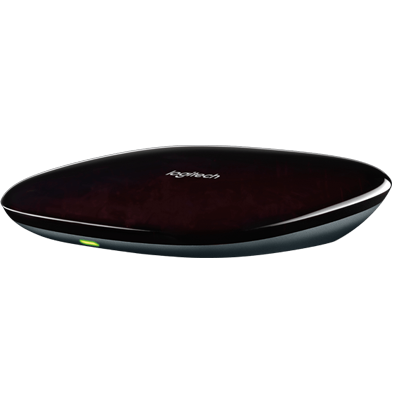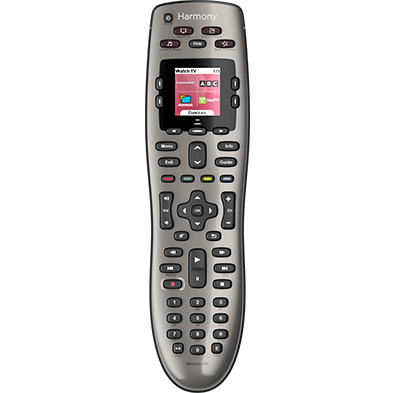Harmony experience with Kodi
It's compatible with Harmony hub-based products

Setup
We're going to discuss adding Kodi as a device, then you'll need to create a Kodi Activity (e.g., Watch TV) and configure it to launch and control Kodi with your Harmony remote. You'll also need to make some additional changes discussed in this section to fully control Kodi with Harmony.
When starting your Watch Kodi Activity for the first time, you must use the Harmony app
Harmony setup for Kodi on Windows
- Add Kodi to Harmony
- During the setup process, Harmony will ask you for the manufacturer and model numbers of your television, AV receiver, and other devices.
- Enter the manufacturer as Microsoft and the model as Kodi.
- If you've already set up Harmony or you're having trouble, please see our Adding Devices article.
- If you're using an OEM IR receiver, enter the manufacturer as Microsoft and the model as Kodi.
- If you're using Flirc, Enter the manufacturer as Flirc and the model as Kodi.
- If you've already set up Harmony or you're having trouble, please see our Adding Devices article.
- Configure your Kodi Activity
- When using a Bluetooth connection, you can use the following steps to configure your Activity to open or close Kodi with your Harmony remote.
- On your PC, create a shortcut to Kodi and right click it.
- Select Properties and click the Shortcut key field, setting it to Ctrl+Alt+1, Ctrl+Alt+2 or Ctrl+Alt+3.
- Add a step at the start of your Kodi Activity, selecting the keyboard shortcut for Kodi as the new command.
- You can configure closing Kodi with Harmony by customizing a button on your remote to do so (Quit).
- Once complete, remember to sync your remote.
Harmony setup for Kodi on Mac
- Add Kodi to Harmony
- During the setup process, Harmony will ask you for the manufacturer and model numbers of your television, AV receiver, and other devices.
- Enter the manufacturer as Apple and the model as Kodi.
- If you've already set up Harmony or you're having trouble, please see our Adding Devices article.
- If you're using an IR port (specific devices only), enter the manufacturer as Apple and the model as Kodi.
- If you're using Flirc, enter the manufacturer as Flirc and the model as Kodi.
- If you've already set up Harmony or you're having trouble, please see our Adding Devices article.
- Configure your Kodi Activity
- When using a Bluetooth connection, you can use the following steps to configure your Activity to open or close Kodi with your Harmony remote.
- On your Mac, launch Automator and navigate to File > New > Service > Choose.
- In the Service receives dropdown box, select no input.
- Select Launch Application by double clicking or dragging it onto the empty canvas on the right.
- In the Launch Application window, select Kodi Home Theater.app then press Command-S to save.
- Navigate to System Preferences > Keyboard > Keyboard Shortcuts, select Add Shortcut and set it to Ctrl+S, Ctrl+W or Ctrl+Z.
- Add a step at the start of your Kodi Activity, selecting the keyboard shortcut for Kodi as the new command.
- You can configure closing Kodi with Harmony by customizing a button on your remote to do so (Quit).
- Once complete, remember to sync your remote.
Control
Harmony Smart Keyboard can act as a fully functional computer keyboard, many apps will also allow you to use your mobile device for control functions. Listed below are some popular apps in the Kodi Channel Derectory as well as ways to control them using Harmony.
Netflix
All Harmony products
Direction Pad Navigation will navigate Netflix.
Media Keys such as play, pause and fast forward do not control Netflix.
With Harmony Smart Keyboard
Text entry is possible using Harmony Smart Keyboard or the Harmony app
Mouse/Cursor control is possible using Harmony Smart Keyboard.
Netflix offers these keyboard shortcuts:
-
SpacebarToggle Play/Pause
-
Left arrowSkip backward 10 seconds
-
Right arrowSkip forward 10 seconds
-
Shift + left arrowRewind
-
Shift + right arrowFast-Forward
-
FEnter full-screen
-
EscExit full-screen
Hulu
All Harmony products
Direction Pad Navigation will navigate Hulu.
Media Keys such as play, pause and fast forward do not control Hulu.
With Harmony Smart Keyboard
Text entry is possible using Harmony Smart Keyboard or the Harmony app
Mouse/Cursor control is possible using Harmony Smart Keyboard.
Hulu offers these keyboard shortcuts:
-
SpacebarToggle Play/Pause
-
Left arrowSkip backward 10 seconds
-
Right arrowSkip forward 10 seconds
-
EscExit full-screen
YouTube
All Harmony products
Direction Pad Navigation will navigate the YouTube app.
Media Keys such as Play, Pause, Stop, Fast-Forward and Rewind commands work. YouTube allows you to navigate between videos using the Skip Forward and Skip backward commands.
With Harmony Smart Keyboard
The YouTube app has an on screen keyboard you navigate using direction keys and does not accept keyboard text entry.
Other apps
The behavior of other apps may vary depending on its design.
Customize
 Adjust the physical buttons on your remote
Adjust the physical buttons on your remote
Harmony has already optimized the buttons on your remote; however you can further customize these buttons depending on your preference.
 Add, remove or rename commands on your remotes screen
Add, remove or rename commands on your remotes screen
Harmony automatically imports your Kodi control options. Commands specific to your Watch Kodi Activity are also displayed for which you can add, remove or rename them.
 Customize Harmony app buttons
Customize Harmony app buttons
You can view common Kodi commands on your phone or tablet screen. You can add, remove or rearrange these commands.
 Set your own swipe gestures
Set your own swipe gestures
By default, swiping up or down on the gestures screen will change volume. There are 22 gestures in total, view and customize them from the app.
FAQs
I need help connecting to Kodi using Bluetooth
Connect with Mac using Bluetooth
Before you can use a Bluetooth device with Mac, you'll need to pair them together. You'll only need to do this once then the device will remain paired until you unpair it.
- Make sure the device is turned on.
- Choose Apple menu > System Preferences, click Bluetooth.
- Select the device you want from the list, then click Pair.
- If you are prompted on the device, click Accept.
Connect with Windows using Bluetooth
If you're not familiar with adding Bluetooth enabled devices to Windows, follow the steps below to get started.
Before you begin
Before you can add a Bluetooth enabled device to your computer, you must do two things to make sure your computer and the device are ready to connect:
- Add a Bluetooth adapter to your computer if it doesn't already have one. You can do this by plugging the adapter into a USB port.
Some computers come with a built-in Bluetooth adapter, especially laptops. You might have to turn on the adapter, or use a switch on your laptop to turn it on if your laptop has one. This might not be called a Bluetooth switch. It might be called a wireless switch, or something similar. If you are unsure about how to turn on the Bluetooth adapter or whether your computer has a built-in Bluetooth adapter, check the manual for your computer or the manufacturer's website.
- Set up the Bluetooth enabled device so that your computer can find it.
To do this, you must first:
- Turn the device on.
- Make it discoverable.
When a Bluetooth enabled device is in discovery mode, it broadcasts a wireless signal that allows it to be detected by other devices or computers. This is sometimes called pairing mode. When most devices are discoverable, they are also in pairing mode, ready to be paired with your computer.
To learn how to make a device discoverable, check the information that came with your device or go to the manufacturer’s website. Methods for making a device discoverable can vary widely from one type of device to the next. Some Bluetooth enabled devices are always in discovery mode. Others, such as most mobile phones, need to be placed in discovery mode by selecting discovery from a software menu or pressing a button on the device. Discovery buttons can be very small and hard to spot, often placed on the bottom of a mouse, keyboard, or similar device. The button may be labeled with the word "connect," or another similar term (e.g., a Bluetooth logo or it may not be labeled at all).

To add a Bluetooth enabled device
Once you've verified that a Bluetooth adapter is installed on your computer, and the device you want to connect with is discoverable, you can add most Bluetooth enabled devices to your computer. Here's how:
- Open Devices and Printers by clicking the Start button, then clicking Devices and Printers.
- Click Add a device, and then follow the instructions.
- Click the Bluetooth enabled device you want to add to your computer, and then click Next. If you don't see the device you want to add, make sure the device is turned on and discoverable. If you just turned on the device, it may take Windows several seconds for Windows to detect it.
Windows might ask you to enter a pairing code (sometimes called a PIN or passcode). Most Bluetooth enabled devices need to be paired with your computer before they can exchange information with each other. To do this, they must exchange protected pairing codes. This means that only the wireless devices you authorize can connect with your computer.
You can turn infrared (IR) reception on or off in Security & Privacy preferences. When you turn on IR reception for your Mac, any IR device close to your Mac can control it. You can turn IR reception off to prevent unwanted control of your Mac or to prevent pairing with an IR remote control.
- Choose Apple menu > System Preferences click Security & Privacy, followed by General.
- Click the lock icon to unlock it, then enter an administrator name and password.
- Click Advanced and select Disable remote control infrared receiver to turn off IR reception, or deselect it to turn on IR reception.
- To set your Mac to respond to the commands of a specific remote control (e.g., Harmony), click Pair, then follow the on-screen instructions.
I need help connecting to Kodi using infrared (IR)
Connect with Mac using IR
You can turn infrared (IR) reception on or off in Security & Privacy preferences. When you turn on IR reception for your Mac, any IR device close to your Mac can control it. You can turn IR reception off to prevent unwanted control of your Mac or to prevent pairing with an IR remote control.
- Choose Apple menu > System Preferences click Security & Privacy, followed by General.
- Click the lock icon to unlock it, then enter an administrator name and password.
- Click Advanced and select Disable remote control infrared receiver to turn off IR reception, or deselect it to turn on IR reception.
- To set your Mac to respond to the commands of a specific remote control (e.g., Harmony), click Pair, then follow the on-screen instructions.
Connect with Windows using IR
When adding an IR dongle to your computer, use the software included with your purchase (if applicable) to assist with your setup and in adding device drivers. When dealing with plug and play devices, or a device that's not being detected after installing included software, follow the steps below to further troubleshoot your device:
- On you computer, click the Start button and right click Computer.
- Select Manage, followed by the Device Manager tab.
- Double-click Infrared devices (devices are listed alphabetically) and select Enable.
For more information about how your computer integrates with Bluetooth and infrared (IR) devices, please see Apple Support for Mac devices, or Microsoft Support for Windows.
Integration details
Hub‑based remotes
Harmony Hub connects with your computer using infrared (IR) or Bluetooth, allowing you to navigate and control Kodi using either your Harmomy remote or the Harmony app
Integration details
IR remotes
Harmony connects with your computer using infrared (IR), allowing you to navigate and control Kodi using your Harmony remote.
Select your remote
We need to know which type of remote you have in order to provide you the correct instructions. Please select from one of the options below in order to get started.


Incompatible Remote
Instructions on this page are not relevant for the Harmony remote you've selected.
← GO BACK

 Dutch
Dutch English
English French
French German
German Italian
Italian Spanish
Spanish